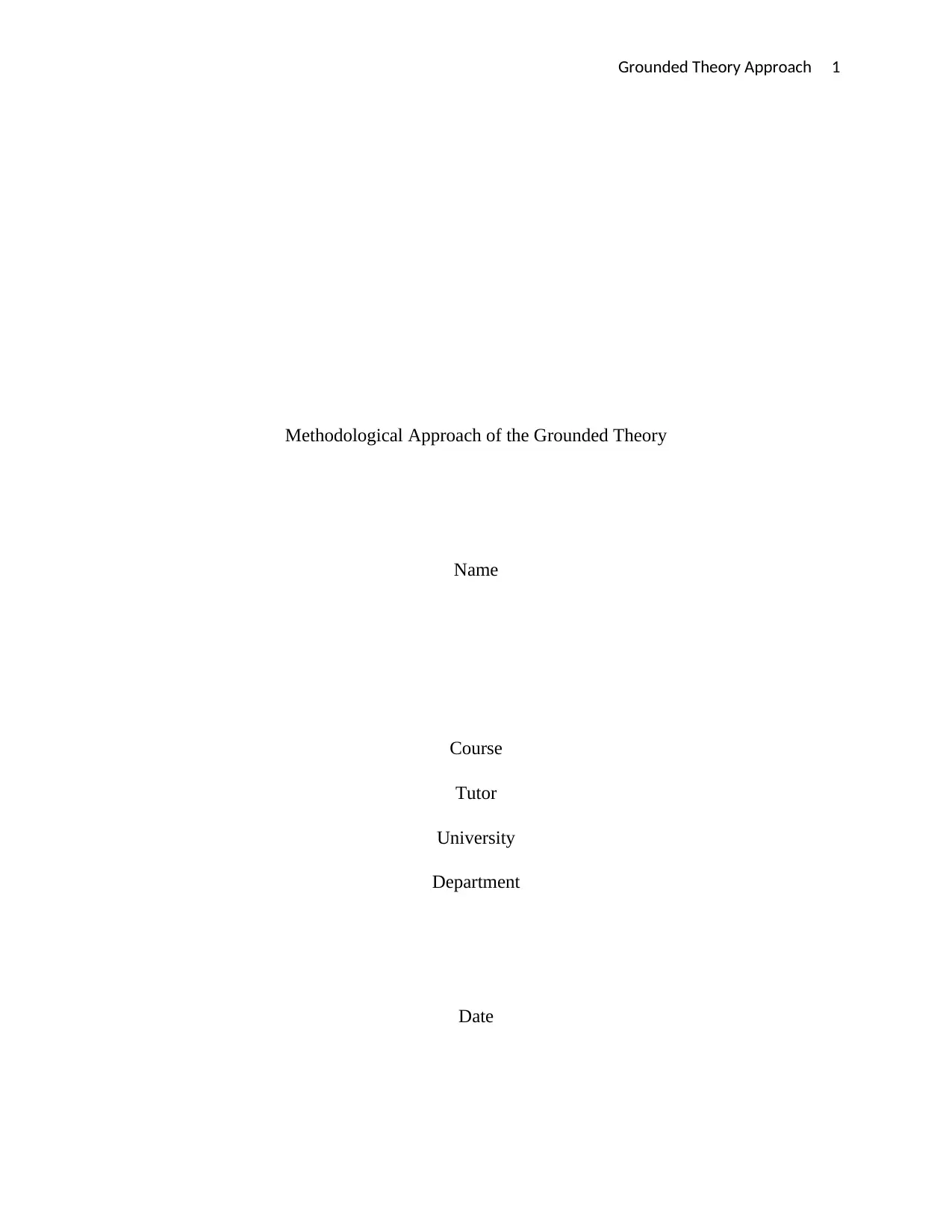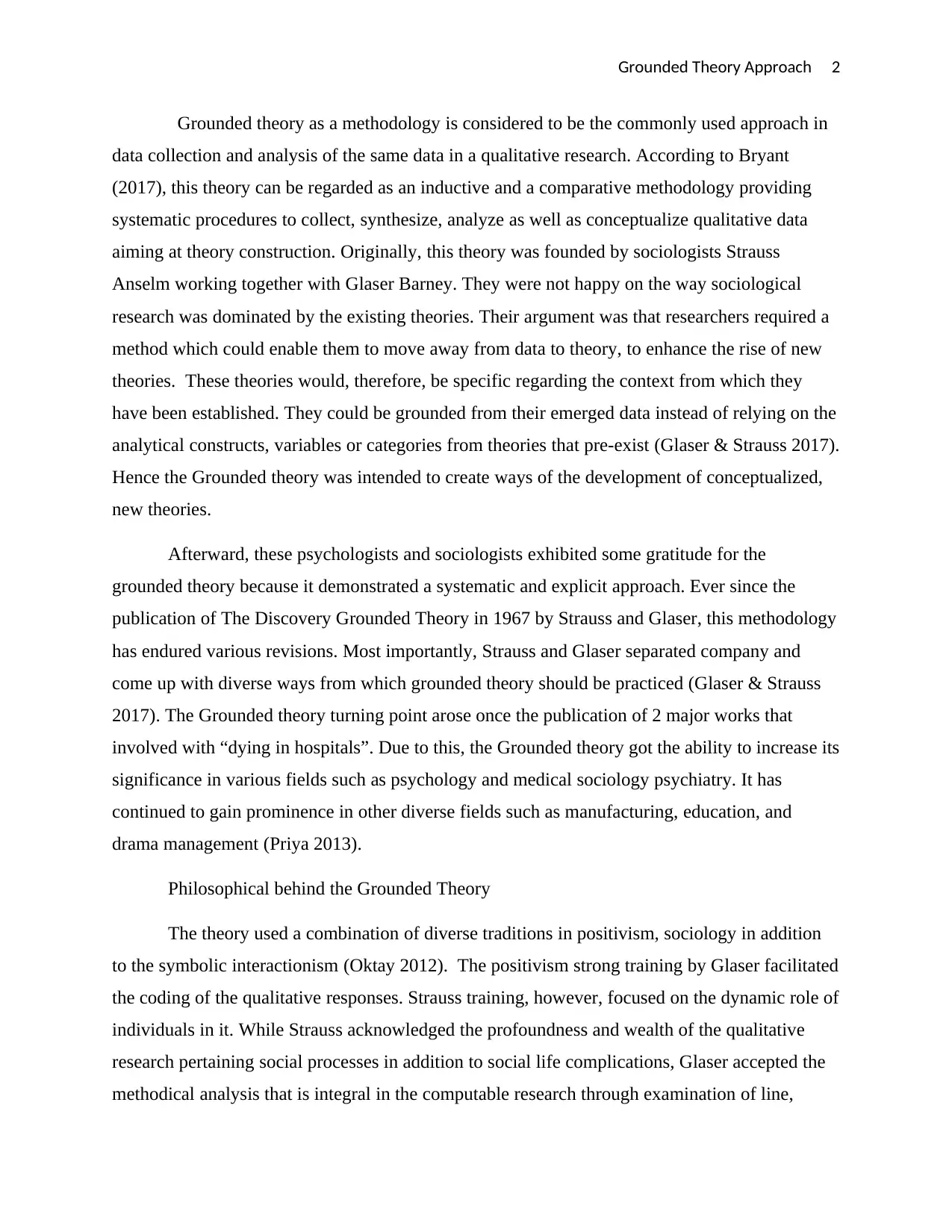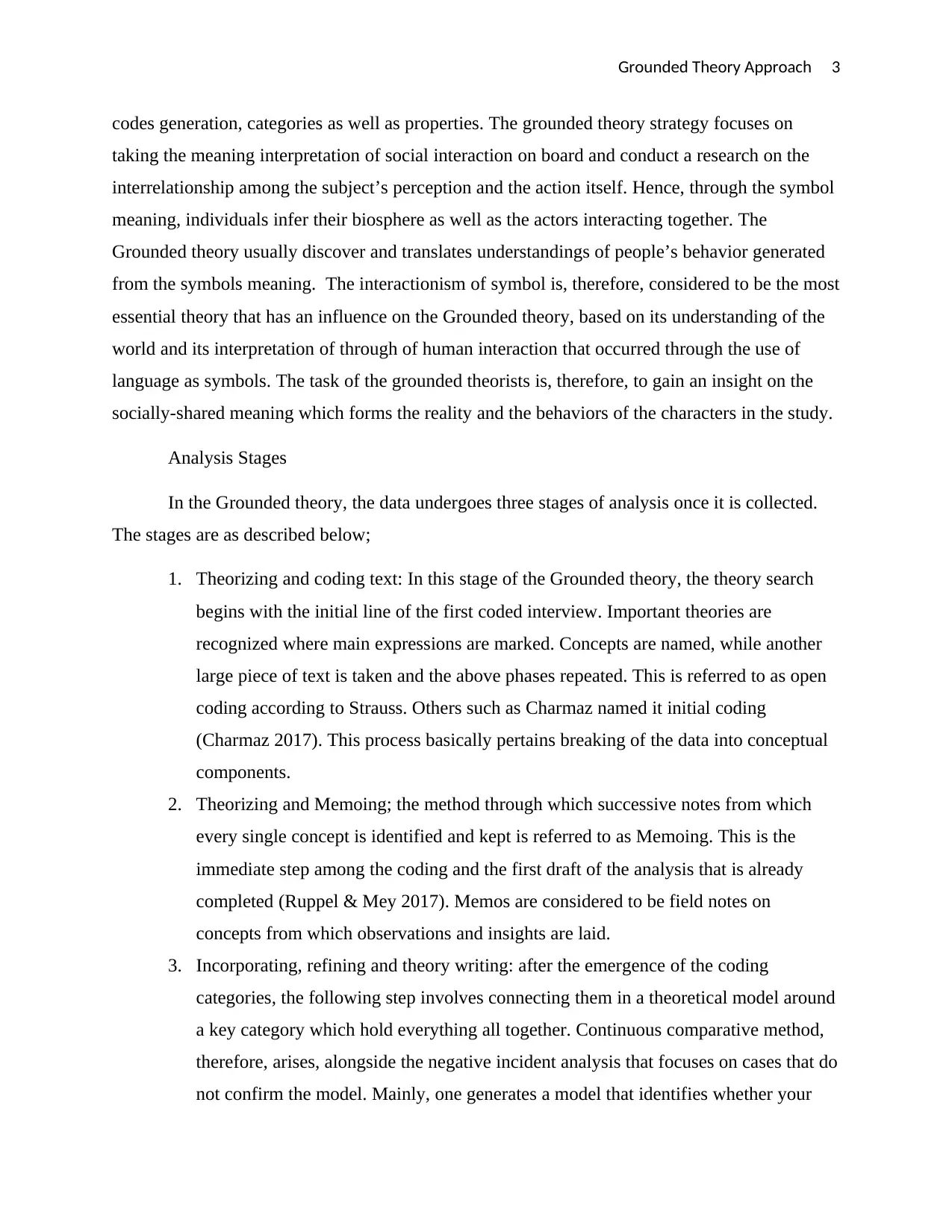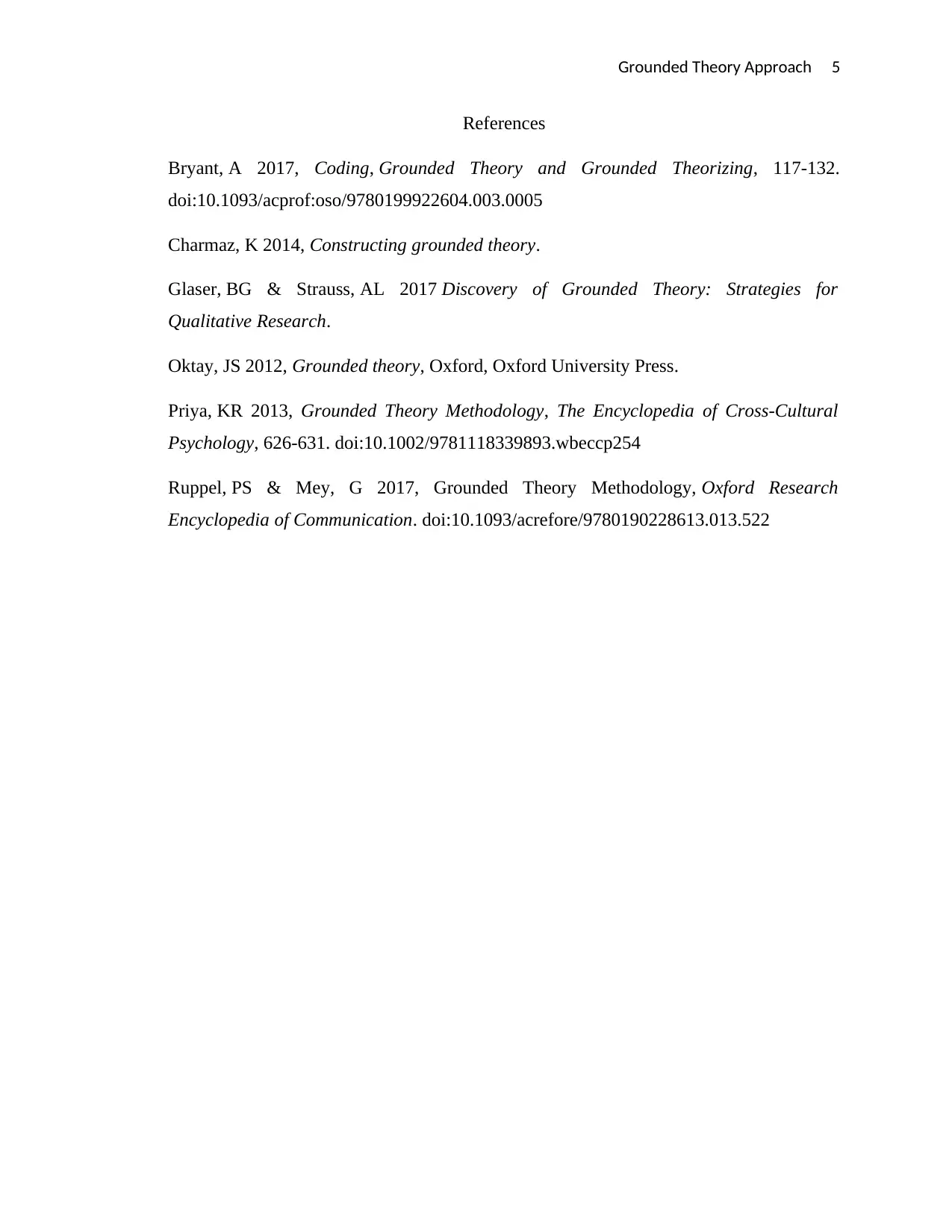A Comprehensive Study of Grounded Theory's Methodological Approach
VerifiedAdded on 2023/06/04
|5
|1032
|403
Essay
AI Summary
This essay provides a detailed overview of the grounded theory approach, a commonly used methodology in qualitative research for data collection and analysis. It traces the theory's origins with sociologists Strauss Anselm and Glaser Barney, highlighting their aim to develop new theories grounded in data rather than pre-existing analytical constructs. The essay explores the philosophical foundations of grounded theory, including its combination of positivism, sociology, and symbolic interactionism. Furthermore, it outlines the three stages of data analysis within grounded theory: theorizing and coding text, theorizing and memoing, and incorporating, refining, and theory writing. The essay emphasizes the continuous comparative method and the importance of negative incident analysis in refining the theoretical model. It concludes by noting the adaptability of grounded theory, allowing researchers to choose between full or abbreviated versions based on their research questions, resources, and time constraints.

Grounded Theory Approach 1
Methodological Approach of the Grounded Theory
Name
Course
Tutor
University
Department
Date
Methodological Approach of the Grounded Theory
Name
Course
Tutor
University
Department
Date
Paraphrase This Document
Need a fresh take? Get an instant paraphrase of this document with our AI Paraphraser

Grounded Theory Approach 2
Grounded theory as a methodology is considered to be the commonly used approach in
data collection and analysis of the same data in a qualitative research. According to Bryant
(2017), this theory can be regarded as an inductive and a comparative methodology providing
systematic procedures to collect, synthesize, analyze as well as conceptualize qualitative data
aiming at theory construction. Originally, this theory was founded by sociologists Strauss
Anselm working together with Glaser Barney. They were not happy on the way sociological
research was dominated by the existing theories. Their argument was that researchers required a
method which could enable them to move away from data to theory, to enhance the rise of new
theories. These theories would, therefore, be specific regarding the context from which they
have been established. They could be grounded from their emerged data instead of relying on the
analytical constructs, variables or categories from theories that pre-exist (Glaser & Strauss 2017).
Hence the Grounded theory was intended to create ways of the development of conceptualized,
new theories.
Afterward, these psychologists and sociologists exhibited some gratitude for the
grounded theory because it demonstrated a systematic and explicit approach. Ever since the
publication of The Discovery Grounded Theory in 1967 by Strauss and Glaser, this methodology
has endured various revisions. Most importantly, Strauss and Glaser separated company and
come up with diverse ways from which grounded theory should be practiced (Glaser & Strauss
2017). The Grounded theory turning point arose once the publication of 2 major works that
involved with “dying in hospitals”. Due to this, the Grounded theory got the ability to increase its
significance in various fields such as psychology and medical sociology psychiatry. It has
continued to gain prominence in other diverse fields such as manufacturing, education, and
drama management (Priya 2013).
Philosophical behind the Grounded Theory
The theory used a combination of diverse traditions in positivism, sociology in addition
to the symbolic interactionism (Oktay 2012). The positivism strong training by Glaser facilitated
the coding of the qualitative responses. Strauss training, however, focused on the dynamic role of
individuals in it. While Strauss acknowledged the profoundness and wealth of the qualitative
research pertaining social processes in addition to social life complications, Glaser accepted the
methodical analysis that is integral in the computable research through examination of line,
Grounded theory as a methodology is considered to be the commonly used approach in
data collection and analysis of the same data in a qualitative research. According to Bryant
(2017), this theory can be regarded as an inductive and a comparative methodology providing
systematic procedures to collect, synthesize, analyze as well as conceptualize qualitative data
aiming at theory construction. Originally, this theory was founded by sociologists Strauss
Anselm working together with Glaser Barney. They were not happy on the way sociological
research was dominated by the existing theories. Their argument was that researchers required a
method which could enable them to move away from data to theory, to enhance the rise of new
theories. These theories would, therefore, be specific regarding the context from which they
have been established. They could be grounded from their emerged data instead of relying on the
analytical constructs, variables or categories from theories that pre-exist (Glaser & Strauss 2017).
Hence the Grounded theory was intended to create ways of the development of conceptualized,
new theories.
Afterward, these psychologists and sociologists exhibited some gratitude for the
grounded theory because it demonstrated a systematic and explicit approach. Ever since the
publication of The Discovery Grounded Theory in 1967 by Strauss and Glaser, this methodology
has endured various revisions. Most importantly, Strauss and Glaser separated company and
come up with diverse ways from which grounded theory should be practiced (Glaser & Strauss
2017). The Grounded theory turning point arose once the publication of 2 major works that
involved with “dying in hospitals”. Due to this, the Grounded theory got the ability to increase its
significance in various fields such as psychology and medical sociology psychiatry. It has
continued to gain prominence in other diverse fields such as manufacturing, education, and
drama management (Priya 2013).
Philosophical behind the Grounded Theory
The theory used a combination of diverse traditions in positivism, sociology in addition
to the symbolic interactionism (Oktay 2012). The positivism strong training by Glaser facilitated
the coding of the qualitative responses. Strauss training, however, focused on the dynamic role of
individuals in it. While Strauss acknowledged the profoundness and wealth of the qualitative
research pertaining social processes in addition to social life complications, Glaser accepted the
methodical analysis that is integral in the computable research through examination of line,

Grounded Theory Approach 3
codes generation, categories as well as properties. The grounded theory strategy focuses on
taking the meaning interpretation of social interaction on board and conduct a research on the
interrelationship among the subject’s perception and the action itself. Hence, through the symbol
meaning, individuals infer their biosphere as well as the actors interacting together. The
Grounded theory usually discover and translates understandings of people’s behavior generated
from the symbols meaning. The interactionism of symbol is, therefore, considered to be the most
essential theory that has an influence on the Grounded theory, based on its understanding of the
world and its interpretation of through of human interaction that occurred through the use of
language as symbols. The task of the grounded theorists is, therefore, to gain an insight on the
socially-shared meaning which forms the reality and the behaviors of the characters in the study.
Analysis Stages
In the Grounded theory, the data undergoes three stages of analysis once it is collected.
The stages are as described below;
1. Theorizing and coding text: In this stage of the Grounded theory, the theory search
begins with the initial line of the first coded interview. Important theories are
recognized where main expressions are marked. Concepts are named, while another
large piece of text is taken and the above phases repeated. This is referred to as open
coding according to Strauss. Others such as Charmaz named it initial coding
(Charmaz 2017). This process basically pertains breaking of the data into conceptual
components.
2. Theorizing and Memoing; the method through which successive notes from which
every single concept is identified and kept is referred to as Memoing. This is the
immediate step among the coding and the first draft of the analysis that is already
completed (Ruppel & Mey 2017). Memos are considered to be field notes on
concepts from which observations and insights are laid.
3. Incorporating, refining and theory writing: after the emergence of the coding
categories, the following step involves connecting them in a theoretical model around
a key category which hold everything all together. Continuous comparative method,
therefore, arises, alongside the negative incident analysis that focuses on cases that do
not confirm the model. Mainly, one generates a model that identifies whether your
codes generation, categories as well as properties. The grounded theory strategy focuses on
taking the meaning interpretation of social interaction on board and conduct a research on the
interrelationship among the subject’s perception and the action itself. Hence, through the symbol
meaning, individuals infer their biosphere as well as the actors interacting together. The
Grounded theory usually discover and translates understandings of people’s behavior generated
from the symbols meaning. The interactionism of symbol is, therefore, considered to be the most
essential theory that has an influence on the Grounded theory, based on its understanding of the
world and its interpretation of through of human interaction that occurred through the use of
language as symbols. The task of the grounded theorists is, therefore, to gain an insight on the
socially-shared meaning which forms the reality and the behaviors of the characters in the study.
Analysis Stages
In the Grounded theory, the data undergoes three stages of analysis once it is collected.
The stages are as described below;
1. Theorizing and coding text: In this stage of the Grounded theory, the theory search
begins with the initial line of the first coded interview. Important theories are
recognized where main expressions are marked. Concepts are named, while another
large piece of text is taken and the above phases repeated. This is referred to as open
coding according to Strauss. Others such as Charmaz named it initial coding
(Charmaz 2017). This process basically pertains breaking of the data into conceptual
components.
2. Theorizing and Memoing; the method through which successive notes from which
every single concept is identified and kept is referred to as Memoing. This is the
immediate step among the coding and the first draft of the analysis that is already
completed (Ruppel & Mey 2017). Memos are considered to be field notes on
concepts from which observations and insights are laid.
3. Incorporating, refining and theory writing: after the emergence of the coding
categories, the following step involves connecting them in a theoretical model around
a key category which hold everything all together. Continuous comparative method,
therefore, arises, alongside the negative incident analysis that focuses on cases that do
not confirm the model. Mainly, one generates a model that identifies whether your
⊘ This is a preview!⊘
Do you want full access?
Subscribe today to unlock all pages.

Trusted by 1+ million students worldwide

Grounded Theory Approach 4
study from the first interview works well and continue to check on the model in other
subsequent analysis of interviews.
Depending on the research question, the resources and time constraints, one can choose
between the full or abbreviated grounded theory versions. This theory will continue to
evolve.
study from the first interview works well and continue to check on the model in other
subsequent analysis of interviews.
Depending on the research question, the resources and time constraints, one can choose
between the full or abbreviated grounded theory versions. This theory will continue to
evolve.
Paraphrase This Document
Need a fresh take? Get an instant paraphrase of this document with our AI Paraphraser

Grounded Theory Approach 5
References
Bryant, A 2017, Coding, Grounded Theory and Grounded Theorizing, 117-132.
doi:10.1093/acprof:oso/9780199922604.003.0005
Charmaz, K 2014, Constructing grounded theory.
Glaser, BG & Strauss, AL 2017 Discovery of Grounded Theory: Strategies for
Qualitative Research.
Oktay, JS 2012, Grounded theory, Oxford, Oxford University Press.
Priya, KR 2013, Grounded Theory Methodology, The Encyclopedia of Cross-Cultural
Psychology, 626-631. doi:10.1002/9781118339893.wbeccp254
Ruppel, PS & Mey, G 2017, Grounded Theory Methodology, Oxford Research
Encyclopedia of Communication. doi:10.1093/acrefore/9780190228613.013.522
References
Bryant, A 2017, Coding, Grounded Theory and Grounded Theorizing, 117-132.
doi:10.1093/acprof:oso/9780199922604.003.0005
Charmaz, K 2014, Constructing grounded theory.
Glaser, BG & Strauss, AL 2017 Discovery of Grounded Theory: Strategies for
Qualitative Research.
Oktay, JS 2012, Grounded theory, Oxford, Oxford University Press.
Priya, KR 2013, Grounded Theory Methodology, The Encyclopedia of Cross-Cultural
Psychology, 626-631. doi:10.1002/9781118339893.wbeccp254
Ruppel, PS & Mey, G 2017, Grounded Theory Methodology, Oxford Research
Encyclopedia of Communication. doi:10.1093/acrefore/9780190228613.013.522
1 out of 5
Related Documents
Your All-in-One AI-Powered Toolkit for Academic Success.
+13062052269
info@desklib.com
Available 24*7 on WhatsApp / Email
![[object Object]](/_next/static/media/star-bottom.7253800d.svg)
Unlock your academic potential
Copyright © 2020–2025 A2Z Services. All Rights Reserved. Developed and managed by ZUCOL.





